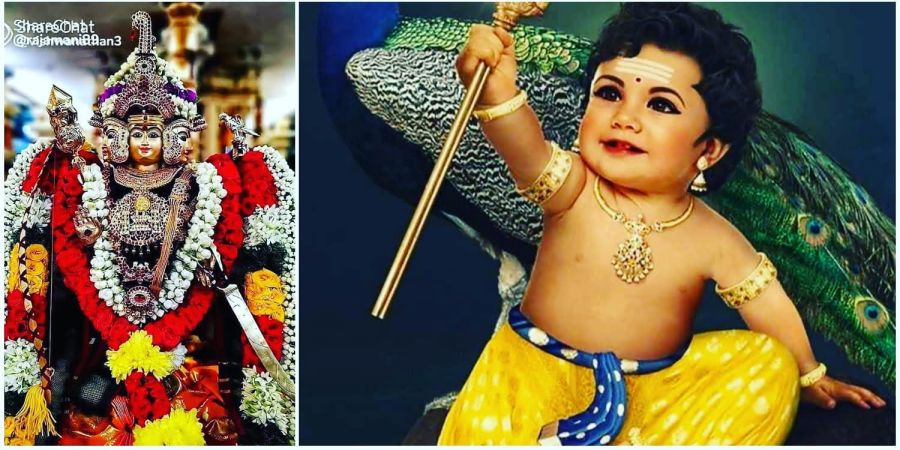

The iconography of Kartikeya varies significantly; he is typically represented as an ever-youthful man, riding or near an Indian peafowl, called Paravani,[16] bearing a vel and sometimes with an emblem of a rooster upon his banner. Most icons show him with only one head, but some show him with six heads which reflect the legend surrounding his birth.He is described to have aged quickly from childhood, becoming a philosopher-warrior, destroyed the demons Tarakasura, Simhamukha and Surapadma, and taught the pursuit of an ethical life and the theology of Shaiva Siddhanta.He has inspired many poet-saints, such as the aforementioned Arunagirinathar.
Murugan is an ancient god, traceable to the Vedic period. He was hailed as 'Palaniappa' (Father of Palani), the tutelary deity of the Kurinji region whose cult gained immense popularity in the south. Sangam literature has several works on Murugan such as Tirumurukāṟṟuppaṭai by Nakkirar and Thirupugal by poet-saint Arunagirinathar. Archaeological evidence from the 1st-century CE and earlier, where he is found with the Hindu god Agni (fire), suggests that he was a significant deity in early Hinduism. He is found in many medieval temples all over India, such as the Ellora Caves and Elephanta Caves.
Murugan is found as a primary deity in temples wherever communities of the Tamil people live worldwide, particularly in the Tamil Nadu state of India, Sri Lanka, Mauritius, Indonesia, Malaysia, Singapore, South Africa, Canada, and Réunion. The Aru Padai Veedu are the six temples of Tamil Nadu that are dedicated to him.The Kataragama temple dedicated to him in Sri Lanka attracts Tamils, Sinhalese people and Vedda people.He is also found in other parts of India, sometimes as Skanda, but in a secondary role along with Ganesha, Parvati and Shiva.
The Subramaniam temple at Thiruparunkundram is situated six miles south of Madurai. It is a cave-temple located up on a small hill which was built in the 8th century by a king named Maravarman Sundara Pandiyan. Murugan is worshipped as Subramaniyan at the shrine, and this is where he got married to Deivanai, the daughter of Lord Indra.
2. Thiruchendur Murugan Temple (Thirucheeralaivaai) - Thiruchendur, Thoothukudi district - Destroying the asura Surapadman
The main shrine of Murugan is called Senthinathan, and the two Utsava murtis of Thiruchendur Murugan are Jayanthi Nathar and Shanmukhar. Of all the six abodes, this is the only abode located near the seashore. Lord Murugan destroyed the asura Surapadman here, using his Vel(spear) given to him by his mother Parvathi. He also used the Vel in the naazhi kinaru (sacred well) to get water for the people when there was a drought. The Naazhi Kinaru is located south of the temple and devotees use the well water to cleanse themselves prior to worshipping the deity. The Soorasamharam festival is celebrated every year, rejoicing the victory over Surapadman and the asuras by Skanda, combined with the Kandha Shasti festival.
3. Palani Murugan Temple (Thiruvavinankudi) - Pazhani, Dindigul district - Lost the Gnana Pazham
Lord Murugan enshrines as Lord Dandayuthapaani holding a staff (Dandam) in the popular hill temple of Palani. According to ancient mythology, the origin of the temple is based on a story where the sage Naratha presented the fruit of Knowledge (Gnana pazham) to Lord Shiva. Lord Shiva decided to give to one of his sons Ganesh and Muruga, and held a competition between the both of them. The competition was that the fruit would be handed over to the son who first circled the world three times. Murugan immediately took his vahana(vehicle), the peacock, and fled to circle the world. But to Lord Ganesh, the world is his parents and nothing else meant more to him. Hence, he walked around his parents thrice, and won the fruit of Knowledge. When Murugan returned, he found that his elder brother had already won the fruit. Out of sheer disappointment and frustration, he left Kailash and stood atop the Palani Hills.
4. Swamimalai Murugan Temple (Thiruverakam) - Swamimalai, kumbakonam - Preaching the Pranava Mantra “OM”
Lord Murugan is worshipped as Balamurugan and as Swaminatha Swami. The temple is said to be the place where Murugan preached the meaning of the Pranava Mantra “OM” to his father Lord Shiva. Hence this abode is known for its uniqueness, where the son is the teacher and the father is the student. The vahana of Murugan in this abode is an elephant instead of the peacock, and it is believed that the elephant, named Airavatha, was gifted to Murugan by Lord Indra.
5. Thiruthani Murugan Temple (Kundruthoraadal) - Thiruthani, Thiruvallur district - Marriage with Sri Valli
Lord Murugan enshrines in this temple as Tanikaslam. In this abode, he got back his inner peace after the war with the asuras. The name Thiruthani means "blissful repose" and it is here that Lord Muruga met Valli and fell in love with her. The divine marriage between Lord Murugan and Sri Valli took place in this abode. The main festival of the temple is Aadi Karthigai, where thousands of devotees carry kavadees (a wooden structure) on their shoulders. The kavadee is symbolic of burdens going on in one’s life, and devotees pray to the Lord to remove their burdens or sufferings. The devotees cheerfully carry the kavadee, singing devotional songs of Muruga, and dance their way up to the temple.
6. Pazhamudircholai Murugan Temple (Pazhamudircholai) - Pazhamudircholai, Madurai district - Darshan to devotees with both his consorts
Lord Murugan in this shrine is known as Kurinji Nilam Kizhavan, and stands along with his consorts Deivanai and Valli, which makes it the only temple amongst the six abodes where he blesses his devotees along with his consorts. The temple is also known as Solaimalai temple, and stands on the slopes of the Alagar hills, about twelve miles east of Madurai. The temple has three shrines worshipping Lord Ganesha, Lord Murugan with his consorts, and Lord Shiva.
